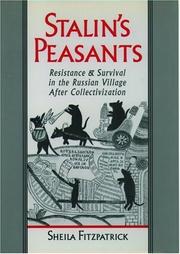Check nearby libraries
Buy this book

Drawing on newly-opened Soviet archives, especially the letters of complaint and petition with which peasants deluged the Soviet authorities in the 1930s, Stalin's Peasants analyzes peasants' strategies of resistance and survival in the new world of the collectivized village.
Stalin's Peasants is a story of struggle between peasants and Communists over the terms of collectivization. But it is also a story about the impact of collectivization on the internal social relations and culture of the village in the 1930s, exploring questions of authority, religious practice, feuds, denunciations, and rumors.
For the first time, it is possible to see the real people behind the facade of the "Potemkin village" created by Soviet propagandists. In dramatic contrast to the official story of happy peasants clustered around a tractor and praising Stalin, Fitzpatrick portrays a village in which sullen peasants called collectivization a "second serfdom" and showed their resistance to the new order by working like serfs, that is, doing as little work on the collective farm as they could get away with.
Far from naively venerating Stalin as "the good Tsar," these real-life peasants held Stalin personally responsible for collectivization and the famine, and hoped for his overthrow.
Sheila Fitzpatrick's work is truly a landmark in Soviet studies - the first richly-documented social history of the 1930s, whose perspective "from below" sheds a new light on the whole relationship of Soviet state and society during (and indeed after) the Stalin period. Anyone interested in Soviet and Russian history, peasant studies, or social history will appreciate this major contribution to our understanding of life in Stalin's Russia.
Check nearby libraries
Buy this book

Subjects
Agriculture and state, Collectivization of agriculture, Rural conditions, Peasants, soviet union, Villages, soviet union, Agriculture and state, soviet union, Soviet union, rural conditions, Rural sociology - general & miscellaneous, Agriculture & food supply policies, Social, Cultural & economic aspects of communism, Collectivization of agriculture--soviet union, Agriculture and state--soviet union, Hd1492.s65 f58 1994, 306.3/64/0947Places
Soviet UnionShowing 2 featured editions. View all 2 editions?
| Edition | Availability |
|---|---|
|
1
Stalin's Peasants: Resistance and Survival in the Russian Village after Collectivization
December 7, 1995, Oxford University Press, USA
in English
0195104595 9780195104592
|
aaaa
Libraries near you:
WorldCat
|
|
2
Stalin's peasants: resistance and survival in the Russian village after collectivization
1994, Oxford University Press
in English
019506982X 9780195069822
|
zzzz
Libraries near you:
WorldCat
|
Book Details
First Sentence
"In the winter of 1929-30, the Soviet regime launched a drive for all-out collectivization of peasant agriculture."
Classifications
ID Numbers
First Sentence
"In the winter of 1929-30, the Soviet regime launched a drive for all-out collectivization of peasant agriculture."
Community Reviews (0)
Feedback?History
- Created April 29, 2008
- 10 revisions
Wikipedia citation
×CloseCopy and paste this code into your Wikipedia page. Need help?
| February 4, 2024 | Edited by ImportBot | import existing book |
| December 19, 2023 | Edited by ImportBot | import existing book |
| October 10, 2020 | Edited by ImportBot | import existing book |
| August 4, 2020 | Edited by ImportBot | import existing book |
| April 29, 2008 | Created by an anonymous user | Imported from amazon.com record |










